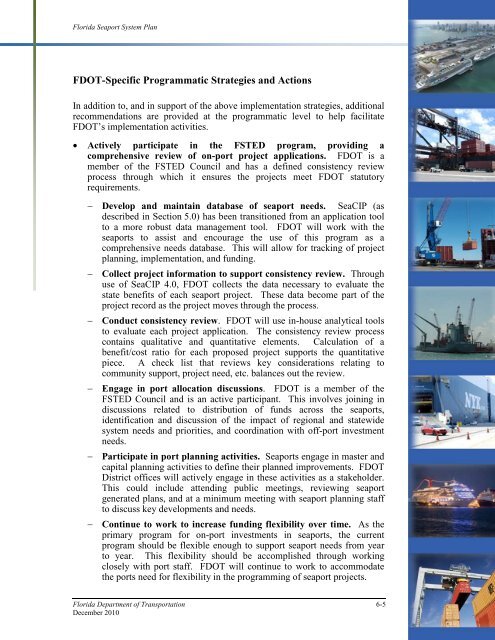Florida Seaport System Plan - SeaCIP
Florida Seaport System Plan - SeaCIP
Florida Seaport System Plan - SeaCIP
Create successful ePaper yourself
Turn your PDF publications into a flip-book with our unique Google optimized e-Paper software.
<strong>Florida</strong> <strong>Seaport</strong> <strong>System</strong> <strong>Plan</strong><br />
FDOT-Specific Programmatic Strategies and Actions<br />
In addition to, and in support of the above implementation strategies, additional<br />
recommendations are provided at the programmatic level to help facilitate<br />
FDOT’s implementation activities.<br />
• Actively participate in the FSTED program, providing a<br />
comprehensive review of on-port project applications. FDOT is a<br />
member of the FSTED Council and has a defined consistency review<br />
process through which it ensures the projects meet FDOT statutory<br />
requirements.<br />
− Develop and maintain database of seaport needs. <strong>SeaCIP</strong> (as<br />
described in Section 5.0) has been transitioned from an application tool<br />
to a more robust data management tool. FDOT will work with the<br />
seaports to assist and encourage the use of this program as a<br />
comprehensive needs database. This will allow for tracking of project<br />
planning, implementation, and funding.<br />
− Collect project information to support consistency review. Through<br />
use of <strong>SeaCIP</strong> 4.0, FDOT collects the data necessary to evaluate the<br />
state benefits of each seaport project. These data become part of the<br />
project record as the project moves through the process.<br />
− Conduct consistency review. FDOT will use in-house analytical tools<br />
to evaluate each project application. The consistency review process<br />
contains qualitative and quantitative elements. Calculation of a<br />
benefit/cost ratio for each proposed project supports the quantitative<br />
piece. A check list that reviews key considerations relating to<br />
community support, project need, etc. balances out the review.<br />
− Engage in port allocation discussions. FDOT is a member of the<br />
FSTED Council and is an active participant. This involves joining in<br />
discussions related to distribution of funds across the seaports,<br />
identification and discussion of the impact of regional and statewide<br />
system needs and priorities, and coordination with off-port investment<br />
needs.<br />
− Participate in port planning activities. <strong>Seaport</strong>s engage in master and<br />
capital planning activities to define their planned improvements. FDOT<br />
District offices will actively engage in these activities as a stakeholder.<br />
This could include attending public meetings, reviewing seaport<br />
generated plans, and at a minimum meeting with seaport planning staff<br />
to discuss key developments and needs.<br />
− Continue to work to increase funding flexibility over time. As the<br />
primary program for on-port investments in seaports, the current<br />
program should be flexible enough to support seaport needs from year<br />
to year. This flexibility should be accomplished through working<br />
closely with port staff. FDOT will continue to work to accommodate<br />
the ports need for flexibility in the programming of seaport projects.<br />
<strong>Florida</strong> Department of Transportation 6-5<br />
December 2010
















